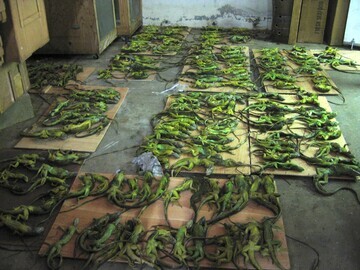Scientist compares death rates in the aquarium and pet reptile trade to a slaughterhouse
“The sickening and scandalously high mortality rates revealed in this article are further evidence that the authorities need to get a better handle on
Scientist compares death rates in the aquarium and pet reptile trade to a slaughterhouse
A damning article about the exotic pet industry, in the latest issue of the Ecologist, explains how vast numbers of reptiles and fish are suffering and dying prematurely both before and shortly after their arrival in the home. A leading wildlife scientist has compared these high death rates to those found in slaughterhouses.
Author, Clifford Warwick, who has investigated the wildlife trade for thirty years as a field biologist, explains that death rates for wild-caught marine fish are about 80% pre-sale, and that almost all pet fish die within a year. For reptiles, pre-sale mortality is around 70%, and between the pet retailer and the home a further 81% of reptiles die within a year. The article entitled 'The exotic pet trade is a global evil that must be stopped' describes the exotic pet industry as hiding 'in plain sight, rooted behind the sanitised façade of pet stores and private homes, quietly facilitated by trade permissive legislation'.
The global exotic pet industry is described as unsustainable and out of control with an estimated 25% of this trade thought to be illegal. Civil servants are blamed for 'molly-coddling' wildlife traders. Warwick states that: "Governments do not entertain guidance on trade policy from drug dealers or people traffickers, yet they accommodate the vested and harmful interests of pet dealers and wildlife traffickers."
Whilst most wild animals indigenous to Europe are protected under European law from being captured and traded as pets, the European Union continues to be a major consumer of wild animals as pets from other parts of the world. The UK in particular plays a major role in this trade but ironically the UK government has stated in relation to native wildlife: "We are not aware that unprotected native wild animals are routinely being captured from the wild and sold abroad as pets and would discourage any such activity."
Says Director of the Animal Protection Agency:
"The sickening and scandalously high mortality rates revealed in this article are further evidence that the authorities need to get a better handle on the exotic pet industry. An enormous diversity of species are traded - most of them wholly unsuitable as pets. Restricting the types of animals that can be traded and kept as pets should therefore now be an urgent priority."
Elaine Toland BSc(Hons) MSB FRSPH
Says the author, Clifford Warwick:
"For decades, wild pet traders have had a free ride at the expense of animal populations, local ecologies, and animal suffering. Whether wild-caught or captive-bred, exotic pets are consumed in an unethical industry wrongly propped-up by overly accommodating civil servants. We need major changes, and we need them now."
Clifford Warwick PGDipMedSci CBiol CSci EurProBiol FOCAE FSB
- For further information or to interview Clifford Warwick, please contact Elaine Toland on 01273 674253 or out of hours on 07986 535024.
- Link to the full article from here.
Animal Protection Agency
15-17 Middle Street
Brighton
BN1 1AL
www.apa.org.uk
Press release distributed by Pressat on behalf of Animal Protection Agency Foundation, on Wednesday 12 November, 2014. For more information subscribe and follow https://pressat.co.uk/
Exotic Pet Industry Mortality Animal Protection Agency Aquarium Trade Reptile Trade The Ecologist Environment & Nature Government
Published By

01273 674253
info@apa.org.uk
http://www.apa.org.uk
kat@apa.org.uk
elaine@apa.org.uk
Visit Newsroom
You just read:
Scientist compares death rates in the aquarium and pet reptile trade to a slaughterhouse
News from this source:


